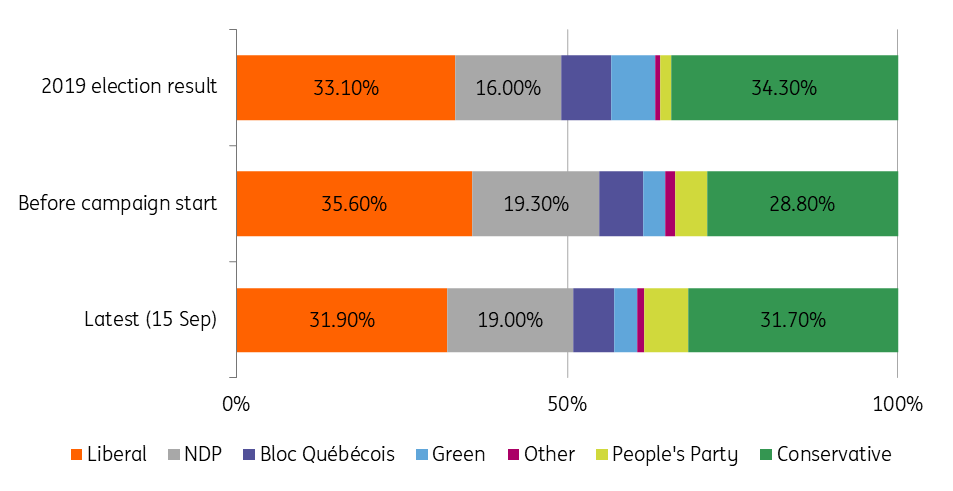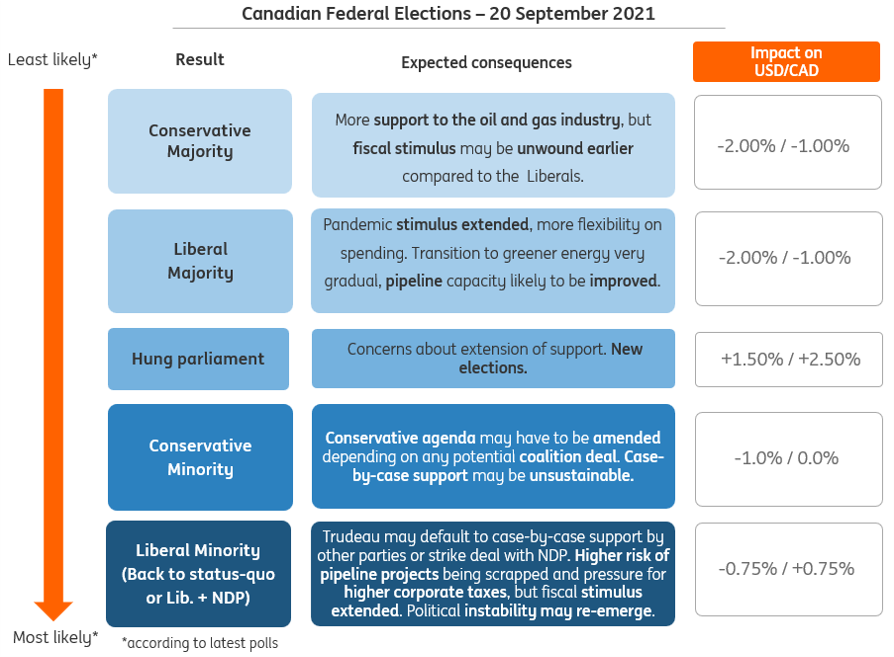Canadian election: Back to square one?
Justin Trudeau had hoped to cash in on popular support and gain an outright majority after calling Monday’s snap election. Opinion polls suggest he will be disappointed. Fiscal stimulus plans and energy/pipeline policy are set to be the main market themes, but a workable majority should ultimately be the key to allow CAD to benefit from good fundamentals
Polls suggest a very tight race
For the past two years, Prime Minister Justin Trudeau’s Liberal Party had to rely on case-by-case support from other parties to push legislation forward. In a surprise move on 15 August he called a snap election – to be held on 20 September – a blatant attempt to cash in on a rise in popularity during the pandemic and secure a clear majority in the Parliament. Since the campaign began, however, things have not gone to plan with opposition parties eating away at that lead. The chart below provides an overview of the latest and pre-campaign opinion polls.

The Liberals currently hold 155 of the 388 seats in the House of Commons. Opinion polls suggest the risks are skewed towards them losing a few of those seats rather than being able to add - they need to gain 15 seats in order to reach the 170 seat threshold that would allow them to govern without the support of another party. If anything, polls suggest that a minority Conservative win is more likely than a majority win by the Liberals, as shown in the polls-implied probabilities in the chart below.

Two key policy points are set to matter the most for markets
The Canadian political debate has covered a number of social and economics topics, but we think only two of them are set to matter much from a market perspective: fiscal stimulus plans and energy/pipeline policy.

Fiscal spending: markets should welcome a continuation of Trudeau’s support
Trudeau’s massive fiscal support programme was a pillar of his government's pandemic-response strategy, with total support nearing 20% of GDP.
Pandemic-induced stimulus is gradually being unwound, but based on the latest campaign pledges, the general feeling is that the Liberals will be more relaxed with further deficit expansions, while the Conservatives have pledged to balance the budget over the long term. Consequently, there is the expectation that they will scale back stimulus quicker than the Liberals, which would likely see slower growth, less inflation and lead to a lessened probability of a major Bank of Canada policy tightening outlook.
The complicating factor is if there isn’t a majority for either party and they need the support of the New Democrat Party (NDP) which is advocating higher corporate, capital gains and income taxes for top earners. If they end up supporting the liberals it may not have as much as an influence on policy thrust as if they partner with the Conservatives.
One caveat concerns Trudeau’s promise to hike tax rates (from 15% to 18%) on all earnings over CA$ 1bn for banks and insurers. Such a measure may send some shockwaves across banking stocks in Canada, but for the moment we think that the prospect of extended fiscal stimulus should be the primary driver of the market response and benefit the Canadian dollar through expectations that fiscal support will allow the Bank of Canada to remain on its policy-normalisation path.
Energy sector: Trudeau is pro-pipeline, but his potential coalition partners are not
The energy sector contributes to approximately 10% of Canada’s GDP every year, but aside from the headwinds generated by the pandemic in the past year, the industry has been looking at some longstanding structural issues that may dent its ability to take advantage of higher oil prices.
A major issue remains the lack of pipeline capacity, as many Canadian oil and gas producers remain heavily dependent on the more expensive rail system as a means of transportation. Trudeau has been historically in favour of expanding Canada's pipeline network, but new projects have found increasing opposition from environmentalist parties (like the Greens and the NDP). Also, this year, US President Joe Biden’s opposition caused the cross-border Keystone XL expansion project to be scrapped.
Despite the Liberals’ official stance for increasing pipeline capacity, the parties that are most likely to join a coalition (like the NDP) are explicitly against it. This means that the more Trudeau will have to rely on coalition deals with left-wing parties to govern, the less likely the pipeline situation is going to be resolved.
The Conservatives are openly in favour of new pipeline projects and retain in general the friendliest stance to the traditional oil-and-gas industry among all parties. Their plans for a transition away from carbon fossil fuels looks likely to be more gradual than that proposed by the other parties, and they plan to actually provide more subsidies to the struggling industry.
From this angle, the markets and Canada's dollar could favour a Conservative win.
Bottom line: A workable majority is what matters the most for CAD
The Canadian dollar has likely discounted some degree of political uncertainty lately as polls showed the Liberal party's hopes for an outright majority becoming more and more distant. Some evidence of this is the risk premium currently embedded into USD/CAD. According to our short-term fair value model (which includes rate differentials, relative equity performance, risk sentiment and commodity factors as variables) USD/CAD is currently 2% overvalued, a level that is above the 1.5 standard-deviation upper bound – as shown in the chart below.

When discussing the two main policy themes that we think markets are mostly keeping an eye on in this Canadian election campaign, we suggest that a minority win by the Liberals could see CAD benefit from better fiscal stimulus prospects, and a minority win by the Conservatives may mean CAD being supported through a better outlook for the oil and gas industry in Canada.
Ultimately, however, we think the market reaction will depend much more on whether the vote will allow room for a workable majority to emerge and guarantee political stability in the coming years, rather than which party will come up as the winner.
The best-case scenario for CAD is undoubtedly a majority win by either one of the two parties, but that seems to be a low-probability outcome if the latest polls are to be trusted. The most likely scenario of either the Liberals or the Conservatives winning most seats but having to rely on other parties (either on a case-by-case basis like the latest government, or through coalition deals) to govern may ultimately have a quite contained impact on CAD.
However, a minority win would pave the way for a potential hung parliament. We should know more on Tuesday, as post-election comments start to outline the different possible political scenarios, but from an FX point of view, we think that any political-noise risk premium embedded in CAD may remain in place until a clear working majority materialises.
Barring the scenario of a hung parliament, political uncertainty in Canada should ultimately dissipate, helping CAD realign with its short-term fair value. The latest data (labour market and inflation) have all but confirmed the view that the Bank of Canada will have to step in with another round of tapering in October, which should leave it on track to fully unwind QE by year-end, or by early-2022. Ultimately, markets will be left with some room to speculate that the first hike will be delivered before mid-2022 (which is currently in the BoC rate-path projections). The set of good fundamentals should, in our view, provide some sustained support to CAD into year-end, and we expect USD/CAD to trade consistently below 1.25 in 4Q21.
Download
Download articleThis publication has been prepared by ING solely for information purposes irrespective of a particular user's means, financial situation or investment objectives. The information does not constitute investment recommendation, and nor is it investment, legal or tax advice or an offer or solicitation to purchase or sell any financial instrument. Read more
